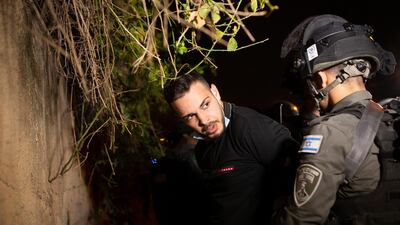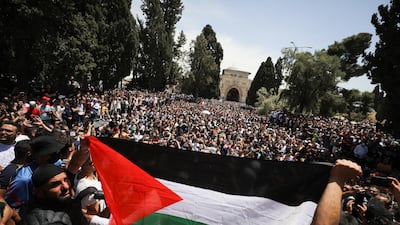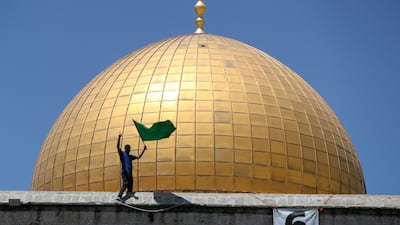The Sheikh Jarrah neighbourhood in East Jerusalem has emerged as a flashpoint in the recent wave of violence that has swept Israel and the Palestinian territories.
A dozen Palestinian families in the district are at risk of losing their homes to Jewish settler groups after a long-running legal battle.
Threats of eviction sparked protests in recent weeks before the violence of recent days.
Property disputes or land grab?
Named after the personal surgeon of Muslim leader Salahuddin Al Ayoubi, whose army liberated Jerusalem from the Crusaders in the 12th century, Sheikh Jarrah was claimed by Israel when it occupied all of Jerusalem in the 1967 Arab-Israeli War.
Israel regards all of Jerusalem as its capital, including Sheikh Jarrah, which lies a short walk from the Old City's Damascus Gate and contains a site revered by religious Jews as the tomb of an ancient priest.
Palestinians want East Jerusalem as the capital of their future state.
A tree-lined area of sandstone homes, hotels and foreign consulates, Sheikh Jarrah is at the centre of what one side frames as a property dispute and the other sees as land seizures that are part of the ongoing occupation of Palestine.
With the creation of the state of Israel in 1948, many Palestinians were forced to leave their homes and relocate to the Palestinian territories or flee to neighbouring countries.
In 1956, 28 refugee families moved into Sheikh Jarrah. They did so with the support of the Jordanian government and material assistance from the UN refugee agency for Palestinians, UNRWA. They have lived in these homes for nearly 70 years.
Situated north of the Old City, Sheikh Jarrah bordered a road that, until 1967, served as a divider between East and West Jerusalem – an area that was not held by either Israel or Jordan.
Last month, Jordan’s Foreign Ministry said it provided the Palestinian Foreign Ministry with 14 ratified agreements to support the people of Sheikh Jarrah in claiming their lands and property.
The paperwork, they said, proves that Jordan's Development Ministry had concluded an agreement with UNRWA to establish 28 housing units in Sheikh Jarrah to be delegated and registered in the names of these families.
The Jordanian Foreign Ministry said it had "found the documents proving that the Ministry of Development that built these houses had, in 1956, finalised lease agreements for homes in Sheikh Jarrah."
However, when Israel occupied Jerusalem and the West Bank in 1967, these documents were disputed.
In 1970, the Law on Legal and Administrative Affairs in Israel was enacted. This stipulated that Jews who lost their property in East Jerusalem before 1948 and that was held by the Jordanian authorities between 1948 and 1967, could reclaim them.
At the same time, the Israeli authorities allowed the takeover of the land and homes of Palestinians in West Jerusalem who fled in 1948 , as well as Palestinians who left because of the Israeli occupation in 1967, by declaring it as "absentees' property".
For years, Israeli courts have heard cases submitted by settlement associations against Palestinian residents, as well as Palestinian appeals against court rulings issued in favour of settlers.
A dozen Palestinian families in the neighbourhood have so far received eviction orders issued by the Israeli central and magistrates courts.
Four Palestinian families have filed a petition with the Supreme Court, Israel’s highest judicial body, against a decision to expel them from their homes.
The neighbourhood with Muslim and Jewish roots
Sheikh Jarrah has historical significance for the national and religious identities of Palestinians and Jews.
Wedged between East and West Jerusalem and near the entrance to the Kidron River Valley, the neighbourhood links the Old City to Mount Scopus, a hill overlooking Jerusalem which has been used as a strategic point by invading armies since antiquity, but is now home to several humanitarian institutions.
Sheikh Jarrah also connects the Arab neighbourhoods in eastern and southern Jerusalem with the Arab neighbourhoods in the northern part of the city.
It also provides a pathway to the north-east part of Jerusalem, where consulates and centres of international organisations such as the International Committee of the Red Cross are housed, thereby granting it geopolitical importance at the municipal and international levels.
An area with a long history
Soon after the death of Sheikh Jarrah, the 13th-century physician, a monument was built at his burial site, which attracted worshippers and visitors over the subsequent centuries.
The Palestinian historian Mujir Al Din, writing in the 15th century, described additional tombs nearby belonging to fallen warriors.
Muslim families began to move outside the walls of the Old City in the late 19th century and built the houses and other buildings that became the core of the neighbourhood.
By 1905, 167 Muslim families lived in Sheikh Jarrah, according to a census when Jerusalem was under Ottoman rule.
At the same time, Jewish residents began to build homes near the tomb of Shimon Hatzadik.
Next to the tomb is another revered site known as the Cave of the Minor Sanhedrin, where members of the judicial body of the Second Temple are buried.
Shimon Hatzadik was a high priest who lived in Jerusalem during the Hellenic period of the Second Temple, a holy structure that stoodbetween 516BC and 70AD.
Testimonies from 19th-century travellers show that the tomb was a pilgrimage destination. Celebrations would take place annually on the holiday of Lag BaOmer, at the same time as the celebrations that took place on Mount Meron – where dozens of worshippers were recently trampled to death.
The competing claims to the tiny neighbourhood are a microcosm of the wider, bitter struggle for territory between the Israelis and the Palestinians.
Palestinians facing eviction orders in East Jerusalem have never won the right to home ownership through the Israeli legal system.
Some have gained protected tenancy status, a temporary measure that allows them to stay put for a few more years.
In the meantime, Palestinian residents rally nightly in Sheikh Jarrah while residents appeal for global support.
Many have sent letters to the International Criminal Court requesting that their case be included in the court’s investigation into alleged war crimes in the Palestinian territories.





































